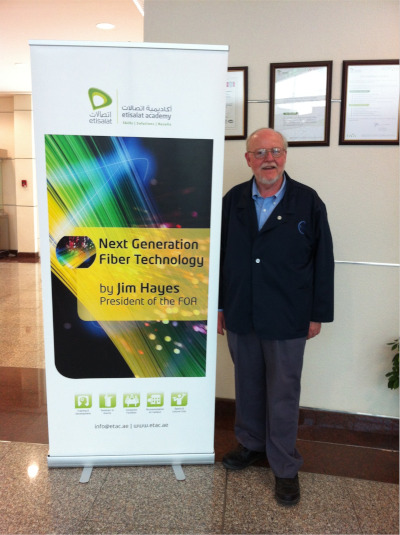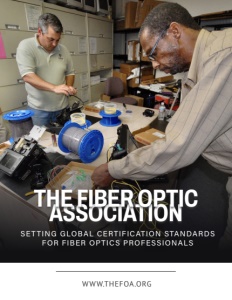The Fiber Optic Association
Setting global certification standards for fiber optics professionals
Setting the industry standard and leveling the fiber optic field with certification solutions
There was a glaring need for certification within the fiber optics field in the mid-1990s which gave rise to a group of leaders within the industry who were instrumental in changing the way professionals are judged. With the formation of an organization dedicated solely to getting them certified to build networks that would power the future, The Fiber Optics Association was born.
The Fiber Optics Association (FOA) is an international non-profit educational body that functions more as a society than a trade group. Its charter is to promote professionalism in fiber optics through education, certification, and standards. FOA is the most widely recognized certifying body for fiber optic technicians worldwide. It has more than a quarter-century of collective experience in developing the fiber optic workforce around the world.
FOA was truly ahead of its time. The organization was founded in 1995 by a dozen prominent fiber optics trainers and leaders from the fiber optic industry, education, and government. They wanted to create a professional organization for fiber optics with the goal of building a competent workforce needed by the fiber optic industry. This is as important in 2023 as it was in 1995 because serious errors can occur when professionals in the fiber optics field tackle projects they are not professionally trained for.
Then and now, hiring in the fiber optics field can be a challenge because it requires specialized knowledge that cannot be truly gained without proper education. That effort to build an educated workforce took hold at the university and technical school levels in the 1990s, with early support for the FOA provided by many notable experts, such as the head trainer of the U.S. Air Force and the head of standards for the U.S. Navy.

Jim Hayes
Even more so, the FOA was also created as a source of independent certification to be used by the industry. It has grown to now being involved in numerous activities to educate the world about fiber optics and certify the workers who design, build and operate its fiber optic networks.
The FOA has essentially created a knowledge base with a worldwide network of experts to create an extensive, noncommercial, reliable knowledge base that is shared with all those working in the field. According to FOA President Jim Hayes, who is also one of the founders, the FOA partners with institutions and organizations globally to conduct training that helps professionals gain the certification they need. This technical information is offered through the FOA website along with textbooks, a Reference Guide, videos on YouTube, and social media posts to its professionals.
“In order to create our own certification, we needed to have a library of our own reference materials,” Hayes says. He authored the first fiber optics certification book in 1997 that highlighted the knowledge, skills and abilities, and technical knowledge needed for success in the field.
After the FOA was formed, Hayes and other early adopters were running industry-wide conferences for fiber optics by the late 1990s. “We’d build a fiber optics surveillance system right there in a hotel room where (the conference) was held,” says Hayes.
Yet, even when it was formed in the mid-1990s, FOA was created as a virtual organization. It has never had a true brick-and-mortar headquarters, with Hayes and his wife moving its “headquarters” (which is also their home) from Boston out to Santa Monica, California, around a decade after the association was founded. He is proud of the fact that the FOA was one of the first professional societies to start after the wide commercialization of the Internet began.
The FOA was chartered as a non-profit and remains so today. Says Hayes, “Our goals haven’t changed in nearly 30 years, and I don’t expect they will anytime soon.” Between that non-profit status and its remote existence, the FOA has successfully maintained a low overhead, thus reinvesting fees and income into growth and education.

Splicing Lab
A certifying body rather than a membership-based organization
Hayes is quick to point out that FOA doesn’t actually have members. It operates solely as a certifying body. But the impact of that body is significant. Since its inception, the FOA has certified more than 89,000 fiber optics professionals around the world. He says nearly 50 percent of all technicians certified by the association live outside of the U.S.
The most common certification offered by the association is the Certified Fiber Optic Technician designation. Training for that certification covers a wide variety of disciplines including installation, splicing and termination, fiber testing, and more.
Says Hayes, “Many global companies within the industry will require professionals to get certified through us. Organizations in Europe, Asia, and Africa require such certification. The United Arab Emirates is one country where an overwhelming number of fiber optics technicians are FOA-certified. “We adhere to international standards that are usable anywhere in the world,” Hayes says.
The evolution of fiber optics growth
Certification courses that FOA supports have evolved over the years from long-haul telecom to metropolitan communities around the globe. Around the time the FOA was formed, cable companies had become the leading provider of broadband services. While those companies like Comcast and AT&T are still major broadband providers, Verizon’s entry into the market around a decade later moved the focus to get fiber connections to individual homes.
These interconnected applications through cellular and wireless companies were essentially created when Steve Jobs first introduced the iPhone in 2007, Hayes says. That has further evolved the industry toward needing warehouse-sized data centers filled with fiber to handle broadband demand and ever-expanding speed.
The issue of broadband access remains a critical one for many rural areas of the country, but also to offer access to inner city residents who may otherwise have difficulty affording such service. The Infrastructure Investment and Jobs Act has set aside $43 billion in federal funding for broadband deployment, especially in rural and tribal areas.
Educational partnerships formed globally to support industry growth
FOA’s online educational tools are wildly popular among fiber optics professionals. It has published 12 textbooks in four languages, Hates says. He also indicated that there are an average of four-million-page downloads from the association’s website in the last few years.
FOA is the standard bearer for industry training, developing partnerships, and authoring the ability for instructors, universities, trade groups, and even governments globally. It has long-lasting partnerships with the National Electrical Contractors Association and the International Brotherhood of Electrical Workers, two trade organizations with tens of thousands of members that utilize FOA training courses in their apprenticeship programs and for members. FOA has 35 training programs specifically for electrical apprenticeships currently running in the U.S.
Trainers are located around the world and are leaders in bringing and advocating for regional certification. Hayes rattled off a list of his colleagues in countries from Japan to France to UAE who have highly specialized training expertise that they bring to professionals through in-person, but mainly online courses. Free, online self-study courses are available through the FOA’s Fiber U page on its website. In addition to courses and tutorials, Fiber U includes links to other web pages focused on fiber optics and premises cabling.
At the end of the day, Hayes has witnessed an incredible transformation in the fiber optics industry over the years. He has seen networks go from megabytes per second to terabytes per second. Over that time though the fiber itself hasn’t changed.
“What has changed,” Hayes says, “is how we cable it, install it and equip it. And we’re the (association) who will keep its professionals educated on best practices.”
AT A GLANCE
The Fiber Optics Association
What: The certifying body for professionals in the fiber optics industry
Where: Global
Website: www.thefoa.org



